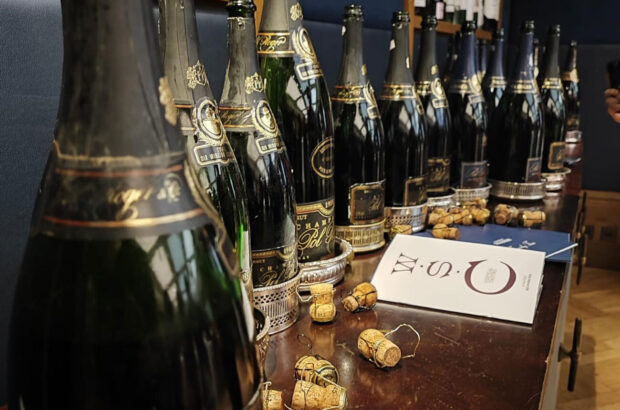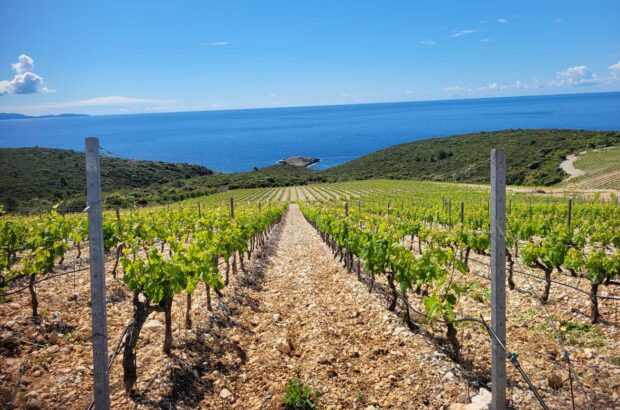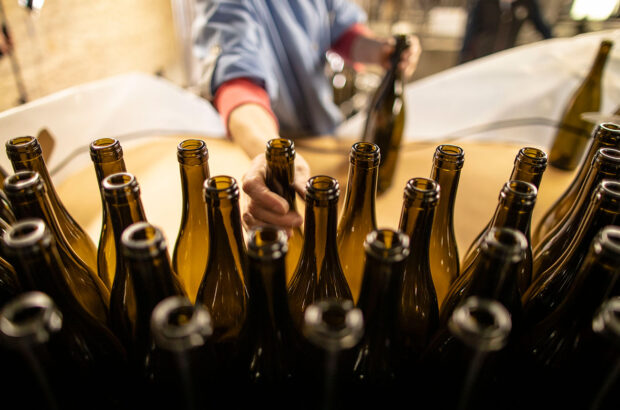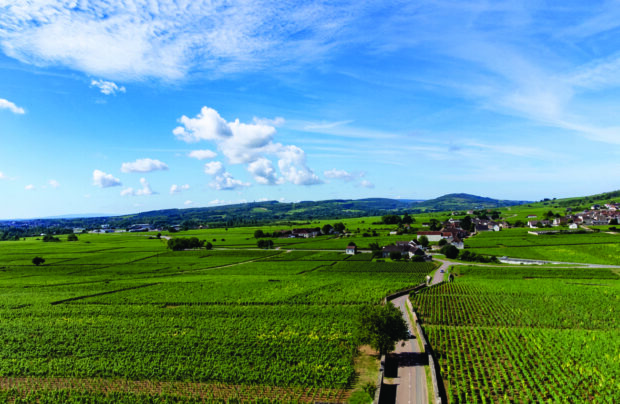- Rightful place well up the quality league.
- Succulence and depth reminiscent of Bordeaux.
- Some of the finest Chinons.
- An integrity of flavour and fruit.
In the heart of the Loire Valley, between Saumur and Tours, the climate softens, the earth warms, and Cabernet Franc grapes flourish sufficiently to make a range of succulent, fruity, often concentrated red wines. Coming from so far north in France, it is something of a miracle that these vines ripen at all: that Chinon, Bourgueil, Saint-Nicolas-de-Bourgueil and Saumur-Champigny can produce fine, sometimes great, red wines, is astonishing. There are two views of these wines. One – you could call it the Paris bistro view – is that they are lightweight, early drinking, best served chilled. The other, the more considered view, is that many of the wines, especially those matured in wood, are much more serious, deserving some ageing, and certainly more consideration than simple quaffing from a pitcher. I have tasted 10 and 15-year old wines, particularly from Chinon, which had developed rich truffle and spice flavours that were as delicious as many mature wines of Saint-Emilion. So, while microclimate – or the few extra degrees of warmth from the Loire and Vienne rivers – gives the Cabernet Franc the opportunity to ripen, it is the current generation of winemakers who have given the appellations both their recent success and their rightful place well up the quality league.
Chinon
This is the largest of the central Loire red wine appellations, and, for me, the most exciting. The vineyards stretch along both banks of the Vienne River, to the east and west of the fortress town of Chinon. This is the land of the French gourmand and philosopher Rabelais, whose birthplace just to the south at Le Logis de la Devinière is now a heavily signposted place of pilgrimage. And Rabelais’ opulent attitude to food and wine is reflected in the wines of Chinon. By far the richest of the Loire reds, fine Chinons in the recent run of excellent vintages (1988, 1989, 1990, 1995, 1996 and 1997) have a succulence and depth of flavour that is often reminiscent of Bordeaux. There’s been an increasing use of wood for ageing – often new or one-year old barrels – that has fleshed out the fruit. There’s also been an interest in producing special cuvées, some of which justify their high prices, some of which seem to be just a marketing trick.
Recommended growers
Bernard Baudry: There are many Baudrys making wine in Chinon, but Bernard is one of the most consistently good. His range moves from a young vine Les Granges, through Domaine Bernard Baudry to a top cuvée, Les Grézeaux.
Jean et Christophe Baudry: These are the other achieving Baudrys, whose 42 hectare (ha) Domaine de la Perrière makes lighter wines than Bernard, which mature quickly, but have all the fruit and suppleness of attractive Chinon.
Paul Buisse: This négociant firm has really improved its Chinon. The special Cuvée Exceptionnel Pour l’An 2000 (a vintage 1996) with its intense colour and use of new wood, will still be young at the Millennium. Other cuvées, such as the Cuvée des Sommeliers 1996, have soft tannins and perfumed flavours.
Couly-Dutheil: The major player in the area, this négociant and domaine operates from cellars dug out beneath Chinon’s great medieval castle. It makes a bewildering array of wines, which accurately reflect the vineyards from which they come. Top cuvées include the single-vineyard Clos de l’Echo and Clos de l’Olive and the blended Baronnie Madeleine.
Château de la Grille: Owned by the Champagne house of Gosset, this no-expense-spared estate is based in one of the few real wine châteaux in Chinon, a 15th century building restored in the 19th century. The wines seem designed for ageing, based on considerable use of new wood, and, in recent good vintages, on ultra-ripe fruit.
Charles Joguet: Poet, philosopher and vigneron, Joguet has a deserved reputation for making some of the finest Chinons. He was the first producer in the region to make single-vineyard cuvées, such as his Clos de la Cure, Varennes du Grand Clos, powerful Clos de la Dioterie from 80-year old vines and Clos du Chêne Vert.
Yves Loiseau: The Domaine du Colombier, Loiseau’s estate, makes powerful, complex wines, of which the Cuvée de la Roche Bobreau seems to age better than the Cuvée Vieilles Vignes.
Alain Lorieux: From his seven hectares, Lorieux makes the hugely perfumed, soft Cuvée Thélème, as well as a more standard cuvée.
Domaine du Roncée: After changes of ownership, the domaine seems to be finding its way again – that is; to judge by the firm tannins and powerful colour of cuvées such as Clos de Folies and, even better, Clos des Marronniers.
Wilfrid Rousse: One of the young generation in Chinon, Wilfrid now has 11ha of vines, and uses ex-Bordeaux barrels for ageing. The wines are firm, with tannins which emphasise ageing potential rather than immediate drinkability.
Bourgueil and Saint-Nicolas-de-Bourgueil
Bourgeuil, an appellation of 1,140ha situated on the north bank of the Loire, never seems to achieve the heights of fine Chinon. Sometimes said (charitably) to need more time to achieve maturity than Chinon, the wines are also described as more rustic. One of the reasons seems to be that, with a few exceptions, producers in Bourgueil have yet to embrace new wood, special cuvées, or that sense of style that is to be found in Chinon.Yet, it is easy to have a soft spot for the best of Bourgueil. There is an integrity of flavour and fruit that, when mature, is well structured and direct. There is an equal simplicity to the village of Bourgueil, when compared with the more sophisticated, touristic town of Chinon. There may be no castle in Bourgueil, but there is an historic abbey, founded by a member of the Baudry family that still plays an important role in both Chinon and Bourgueil.
Saint-Nicolas-de-Bourgueil, the village situated just to the west of Bourgueil is, as an appellation, only about half the size. Its reputation is for making lighter wines than Bourgueil, a reflection of the sandier soils of the vineyard. Many though, would suggest that Saint-Nicolas only received a separate appellation because its vignerons were quicker off the mark in 1937 when the appellations were first granted. Whether it should be separated from Bourgueil or not, its wines are generally more immediately attractive than those of its larger neighbour. There’s a spring and vivacity to them, a general air of fruitiness which has meant that they have become popular as summer reds, slightly chilled. Yet, in better years, and with seriously applied winemaking, they, too, can age well. Many vignerons make wines in both appellations.
Recommended growers
Yannick Amirault, Domaine de la Coudraye: Yannick Amirault makes both Bourgueil and Saint-Nicolas. Particularly good are his Bourgueil Vieilles Vignes Les Quartiers, the 1997 packed with wood flavours and juicy fruit, and Bourgueil La Petite Cave, the 1997 a warm, rich, soft wine.
Audebert et Fils: Three single-vineyard Bourgueils are at the heart of this 40ha domaine. The five-hectare Les Grands Rangs produces attractive cigar box and spice flavoured wines, which mature relatively quickly. Les Marquises are somewhat more tannic, while the wines of Domaine du Grand Clos are richer.
Jean-Yves Billet: Recently retired from the local Syndicat Viticole but as active as he ever was, Jean-Yves Billet makes three cuvées from his 18ha property, Domaine des Forges. The Vieilles Vignes and Les Bézards are the more serious. He also manages Château de Minière, which produces firm, generous wines that age well.
Christophe Chasle: Created in 1979, this small, seven-hectare property is at the far eastern end of Bourgueil. Three wines, Les Gravois, Rochecot and Tuffeau are produced, of which the Rochecot has recently been extremely rich and fine.
Pierre-Jacques Druet: Low yields, a close attention to the nature of his different parcels in Bourgueil and his barrel ageing make this young producer one of the best in the appellation. Four different cuvées are produced by Druet: from lightest to weightiest, they are Les Cent Boissellées, Beauvais, Grand Mont and Vaumoreau.
Pierre Gauthier: These are modern, wood aged, spicy wines. Gauthier makes three cuvées, of which Clos Senechal is the lightest. Les Grands Monts 1996 and Le Peu both have 18 months in new wood, both very perfumed with attractive fruit and wood tannins.
Francis Jamet: With two hectares in Bourgueil and 14ha in Saint-Nicolas, Jamet makes wines under the Domaine des Vallettes label. The 1996 Bourgueil is powerful, with hints of redcurrants and vanilla, the Saint-Nicolas lighter, fresher and easy drinking.
Lamé-Delisle-Boucard: From the Domaine des Chesnaies, this family firm makes sturdy Bourgueils that epitomise the need for ageing. The Cuvée Lucien Lamé 1996 is more fragrant than the Cuvée Prestige 1995 which is characterised by tannins and tight-knit fruit. Other wines produced include a Vieilles Vignes and a lightweight Cuvée de Printemps.
Pascal Lorieux: The Lorieux cellars, in a converted garage in Saint-Nicolas, are hardly romantic, but the wines themselves are clean, ripe and soft with sweet fruit flavours. Cuvée Agnès Sorel is lighter in style than Cuvée les Mauguerets.
Jean-Claude Mabileau: The name Mabileau is widely found among local producers, so the first name is important. Jean-Claude makes two wines, a standard cuvée and the wood-aged Cuvée Concerto.
Bernard et Patrick Olivier: A 22ha vineyard makes the Oliviers big producers in Saint-Nicolas. They make two wines, an attractive standard cuvée Domaine Olivier, and a fuller, more tannic Cuvée du Mont des Olivier (from low-yielding vines).
Joel Taluau: The big name in Saint-Nicolas, Joel Taluau makes Jeunes Vignes and Vieilles Vignes wines which can age remarkably well.
Saumur-Champigny
Although Saumur-Champigny is in Anjou rather than Touraine like the other three central Loire red appellations, it’s so close as to make no difference. You can see the flatter valley of Chinon to the east from the plateau of Saumur-Champigny vineyards which rises sharply up from the southern banks of the Loire, just east of Saumur itself. In the cliffs that front the river are the cellars of many of the producers; there are even some houses whose facades are conventional stone buildings but whose interiors are simply caves in the cliffs.The wines are lightweight in comparison with Chinon’s, but their freshness and vitality, ease and accessibility when young, has made them the darlings of the fish restaurants of Paris. Not all is simply lightness. There are some cuvées from the increasing number of quality-conscious producers which aim for more serious things, with the use of wood as one element in the quest for an ability to age. The three recent vintages from 1995 to 1997 have revealed an impressive amount of colour and extract, as well as a depth of fruit that would have been unheard of in the past.
Recommended growers
Château de Chaintres: Around a 17th-century house, the 20ha of Château de Chaintres produce wines with pure fruit, concentrated flavours and soft, dusty tannins. Those from 1996 are excellent.
Daheuiller: This family owns Domaine des Varinelles, a 38ha property. Two cuvées are produced: the concentrated Cuvée Vieilles Vignes and the lighter Domaine des Varinelles.
Domaine Filliatreau: One of the principal properties in Saumur-Champigny, in at the beginning of the appellation’s current success. The family has a 45ha property, producing a number of immediately attractive wines, Jeunes Vignes, the more concentrated Vieilles Vignes and the single vineyard Cuvée Le Grand Vignolle.
Château du Hureau: One of the most reliable, sometimes exciting producers of Saumur-Champigny, Philippe Vatan makes two cuvées, a standard wine and one from old vines, which is wood aged. Sometimes, if the grapes ripen, he will use a high proportion of Cabernet Sauvignon.
Langlois-Chateau: Apart from its principal business as producer of sparkling Crémant de Loire, the Langlois-Chateau company makes a range of still wines. The Saumur-Champigny Château de Varrains is packed with new wood, with excellent colour and clean, pure fruit.
Domaine des Roches Neuves: Thierry Germain is Bordelais in origin. He makes two wines, a Jeunes Vignes and a succulent Vieilles Vignes from a parcel of land he calls Terre Chaude (warm earth).
Clos Rougeard: The Foucaults make some of the very best Saumur-Champigny, from their tiny eight-hectare vineyard. There are three cuvées, Clos Rougéard, Les Poyeux and Le Bourg, of which the last two are matured in wood. The wines are powerful, sumptuous, certainly not lightweight.
Domaine de Saint-Just: Yves Lambert’s wines are modern in style, emphasising purity of attractive fruit. This is particularly true of La Montée des Roches, while the Le Clos Moleton cuvée, deep and rich, also has a layer of wood.
Château de Targé: The château of the Pisani-Ferry family is built into the cliff face facing the Loire. The two principal wines made are a traditional Château de Targé, and the serious Cuvée Ferry.
Cave des Vignerons de Saumur: The big cooperative of St-Cyr-en-Bourg makes freshly attractive, pleasing Saumur- Champigny Reserve des Vignerons.











